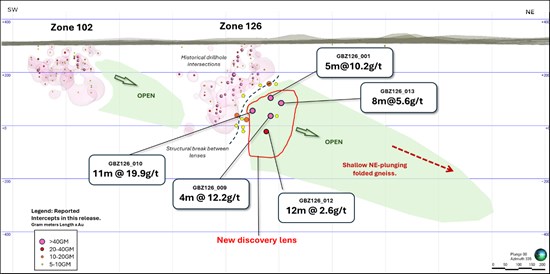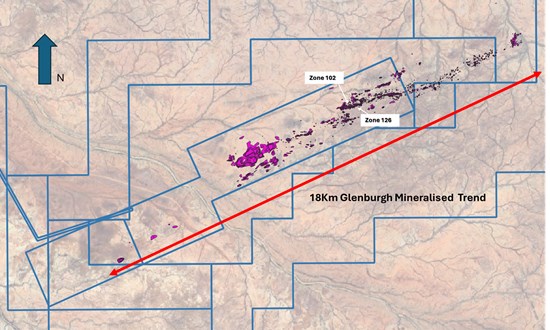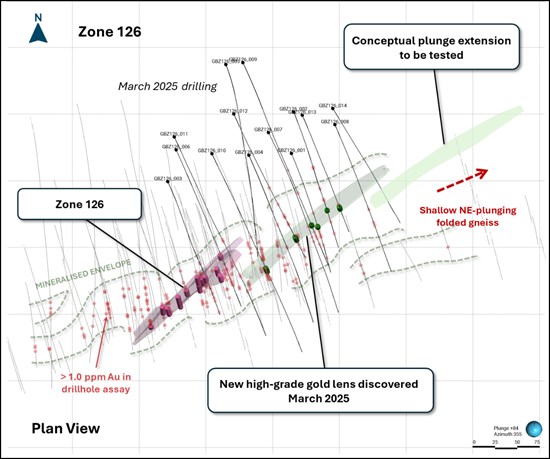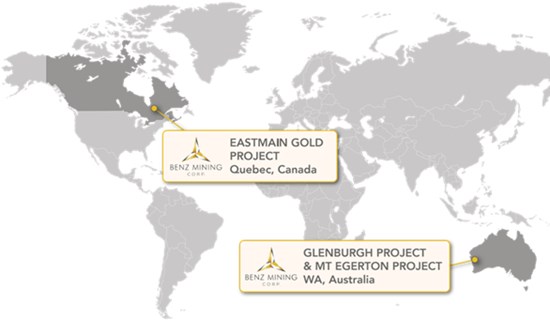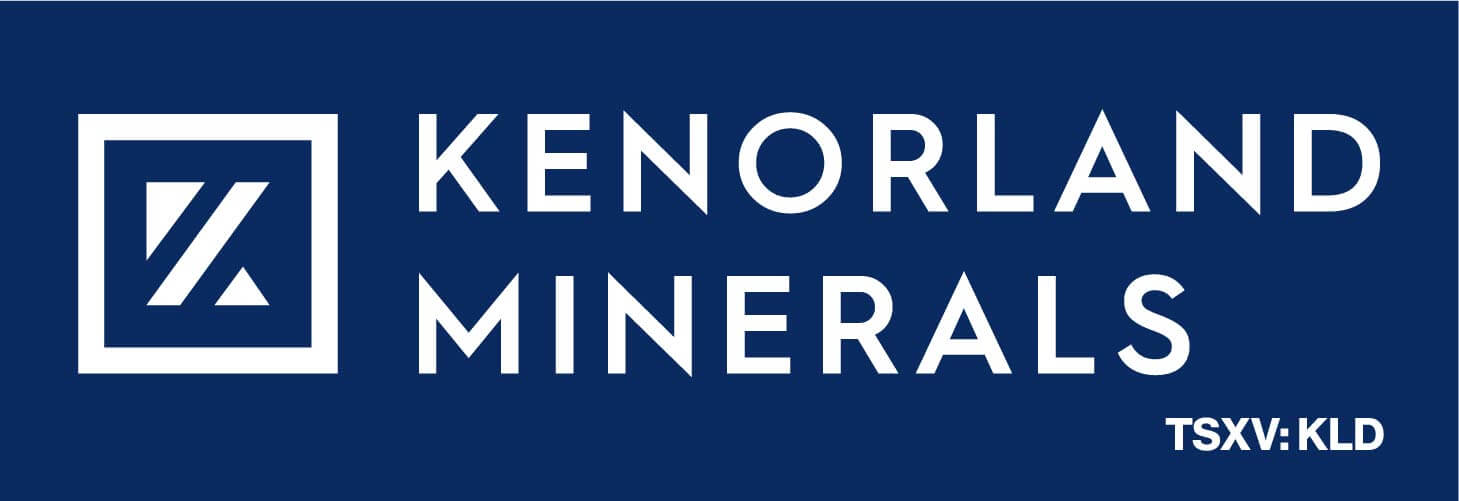Benz Delivers a New High Grade Gold Discovery at Glenburgh
HIGHLIGHTS:
-
New High-Grade Gold Discovery: Benz initial results from maiden drilling at the Zone 126 target at the Glenburgh Gold Project have revealed a significant new high-grade gold lens approximately 80m down-plunge from previously interpreted gold mineralisation.
-
Significant intercepts include:
-
11m at 19.9g/t gold from 274m (GBZ126_010)
-
5m at 10.2g/t gold from 222m and 7m at 3.5g/t gold from 233m (GBZ126_001)
-
4m at 12.2g/t gold from 319m (GBZ126_009)
-
8m at 5.6g/t gold from 243m (GBZ126_013)
-
-
-
Targeting Model Confirmed: Drilling at Zone 126 has validated Benz’s initial structural interpretation, confirming a previously unrecognised overall NE plunge to the mineralised system compared to previous exploration which focused mainly on shoots plunging to the SW.
-
First Drilling with New Insights: Importantly, this is the first time the Glenburgh gold system has been drilled using this refined model, opening up the entire Glenburgh 18km mineralised corridor to untested fold plunge targets.
-
Significant Discovery Potential: With a confirmed exploration model and multiple untested gold targets, Benz is now positioned to unlock a potentially much larger mineralised system with substantial upside.
-
Advanced Surface Mapping Underway: Extensive outcrop exposure across the project area is enabling detailed surface geological mapping to be conducted. Early work confirms that the NE fold geometries are visible at surface-providing a powerful tool to pinpoint the next round of untested down-plunge drill targets.
Figure 1. Long section Z126 Drilling.
To view an enhanced version of this graphic, please visit:
https://images.newsfilecorp.com/files/1818/247193_b6f87f29a438ba3e_001full.jpg
Vancouver, British Columbia–(Newsfile Corp. – April 2, 2025) – Benz Mining Corp (ASX: BNZ) (TSXV: BZ) (“Benz” or the “Company”) is pleased to report the first results from its maiden 8,500m RC drilling program at the 100%-owned Glenburgh Gold Project in Western Australia. This announcement covers results from 13 of the 21 holes completed to date, with assays from the remaining holes expected towards the end of this Quarter.
Zone 126 was discovered by previous owners, Gascoyne Resources Limited and Helix Resources Limited, and includes previous wide high-grade gold intercepts such as:1
-
24m at 9.1g/t gold (VRC535)
-
10m at 11.6g/t gold (VRC201)
-
28m at 5.0g/t gold (VRC 580)
-
12m at 8.1g/t gold (VRC174)
-
8m at 11.6g/t gold (VRC 176)
-
14m at 8.9g/t gold (VRC578)
Mineralisation at Zone 126 (Figure 2) outcrops at surface and was previously drilled to approximately 200m below surface where the mineralisation appeared to pinch out at depth along a steep SW-plunge. During due diligence for the acquisition of the Glenburgh Gold Project, Benz structural geologists identified the folded geometry of gneissic rocks hosting gold mineralisation was plunging shallow to the NE suggesting continuity of Zone 126 in this direction, a model promptly validated by drilling in March 2025.
Figure 2. Plan viewing showing the extent of the known mineralised trend as detailed in historical surface Au sampling (>25ppb)
To view an enhanced version of this graphic, please visit:
https://images.newsfilecorp.com/files/1818/247193_b6f87f29a438ba3e_002full.jpg
Shown below in Figure 3, is a plan view detailing the drill collar locations and the newly discovered high-grade gold lens at Zone 126. Figure 3 also outlines the conceptual position identified by the new structural model which will be the next priority drill target down plunge. This highlights the significant potential for further high-grade discoveries along the untested north-east plunge corridor.
High-grade gold intercepts at Zone 126 are hosted within a broad mineralised envelope, up to 70m wide, of elevated gold. Within this envelope, significant patches of higher-grade material ranging between 1-10g/t gold have been intersected, highlighting the scale, continuity, and potential for bulk-disseminated style gold mineralisation.
All holes to date have been drilled via reverse circulation drilling to depths in excess of 500m, while maintaining full recovered and dry samples. This has allowed Benz to rapidly and cost-effectively test targets at depths that are often beyond this drilling methods range.
Figure 3. Plan view of reported holes, with position of new discovery lens.
To view an enhanced version of this graphic, please visit:
https://images.newsfilecorp.com/files/1818/247193_b6f87f29a438ba3e_003full.jpg
Benz CEO, Mark Lynch-Staunton, commented:
“We are absolutely thrilled with the results of our maiden drilling program at Zone 126. Not only have we hit one of the highest ever gold intercepts on the entire project to date in our maiden program, but more importantly, we have confirmed our concept that completely turns the structural understanding of the Glenburgh Gold Project on its head. This extension is a significant high-grade gold discovery. It’s the first time this gold deposit has been drilled with our refined targeting approach, and the results speak for themselves.
“Not only have we intersected exceptional grades, but we’ve also opened up the entire 18km mineralised gold corridor to untested north-east fold plunge targets. With advanced surface mapping now underway and clear structural controls visible at surface, we’re in a strong position to identify and drill the next round of high-potential targets. This is a huge step forward for the Glenburgh Gold Project, and we believe we’re just scratching the surface of the true potential of what we believe could be a multi-million ounce gold system.”
The Company has also agreed to issue a total of 8,000,000 options to certain consultants of the Company. All were granted in accordance with the Company’s Omnibus Equity Incentive Compensation Plan and are in accordance with policies of the TSX Venture Exchange. 4,000,000 options have an exercise price of C$0.45 and 4,000,000 options have an exercise price of C$0.90, with all options expiring on 2 April 2028.
This announcement has been approved for release by the Board of Benz Mining Corp.
For more information please contact:
Mark Lynch-Staunton
Chief Executive Officer
Benz Mining Corp.
E: [email protected]
T: +61 8 6143 6702
About Benz Mining Corp.
Benz Mining Corp. (TSXV: BZ) (ASX: BNZ) is a pure-play gold exploration company dual-listed on the TSX Venture Exchange and Australian Securities Exchange.
On 6 November 2024, Benz announced a binding agreement to acquire the Glenburgh and Mt Egerton Gold Projects in Western Australia from Spartan Resources Limited (ASX: SPR), which was completed on 14 January 2025 and marks a transformational step, establishing Benz as a multi-jurisdictional gold exploration company with a focus on unlocking value in underexplored assets. The Glenburgh Gold Project features a Historical (for the purposes of NI 43-101) Mineral Resource Estimate of 16.3Mt at 1.0 g/t Au (510,100 ounces of contained gold)2. A technical report prepared under NI 43-101- Standards of Disclosure for Mineral Projects (NI 43-101) titled “NI 43-101 Technical Report on the Glenburgh – Egerton Gold Project, Western Australia” with an effective date of 16 December 2024 has been filed with the TSX Venture Exchange and is available under the Company’s profile at www.sedarplus.ca.
Benz’s key point of difference lies in its team’s deep geological expertise and the use of advanced geological techniques, particularly in high-metamorphic terrane exploration. The Company aims to rapidly grow its global resource base and solidify its position as a leading gold explorer across two of the world’s most prolific gold regions.
The Company also owns the Eastmain Gold Project in Quebec, with a Mineral Resource Estimate dated effective May 24, 2023 and prepared in accordance with NI 43-101 and JORC (2012) of 1,005,000 ounces at 6.1g/t Au3, also available under the Company’s profile at www.sedarplus.ca, showcasing Benz’s focus on high-grade, high-margin assets in premier mining jurisdictions.
To view an enhanced version of this graphic, please visit:
https://images.newsfilecorp.com/files/1818/247193_b6f87f29a438ba3e_004full.jpg
For more information, please visit: https://benzmining.com/.
Competent Person’s Statement (JORC Code)
The information contained in this announcement that relates to new Exploration Results for the Glenburgh Gold Project, is based on and fairly reflects, information compiled by Dr Marat Abzalov. Dr Abzalov is an independent consultant (MASSA Geoservices) and was engaged by Benz Mining Corp. Dr Abzalov is a Fellow of The Australasian Institute of Mining and Metallurgy (#202718) and has sufficient experience which is relevant to the style of mineralisation and type of deposit under consideration. Dr Abzalov has shares in Benz Mining Corp. Dr Abzalov consents to the inclusion in the report of the matters based on his information in the form and context in which it appears
The Mineral Resource Estimates for the Eastmain Project and the Glenburgh Gold Project were previously reported in accordance with Listing Rule 5.8 on 24 May 2023 and 6 November 2024, respectively. The Company confirms that it is not aware of any new information or data that materially affects the information included in the original market announcements and confirms that all material assumptions and technical parameters underpinning the Estimates continue to apply and have not materially changed. The Company confirms that the form and context in which the Competent Person’s findings are presented have not been materially modified from the original market announcements.
The information in this announcement that relates to historical exploration results for the Glenburgh Gold Project was first reported to the ASX in accordance with ASX Listing Rule 5.7 on 6 November 2024. The Company confirms that it is not aware of any new information or data that materially affects the information included in the original market announcement.
Qualified Person’s Statement (NI 43-101)
The disclosure of scientific or technical information in this news release is based on, and fairly represents, information compiled by Dr Marat Abzalov. Dr Abzalov, who is a Qualified Person as defined by NI 43-101, and member in good standing as a Fellow of The Australasian Institute of Mining and Metallurgy (#202718). Dr Abzalov has reviewed and approved the technical information in this news release. Dr Abzalov owns shares in Benz Mining Corp.
Historical Mineral Resource Estimates
All mineral resource estimates in respect of the Glenburgh Gold Project in this news release are considered to be “historical estimates” as defined under NI 43-101. These historical estimates are not considered to be current and are not being treated as such. These estimates have been prepared in accordance with the Australasian Code for Reporting of Exploration Results, Mineral Resources and Ore Reserves prepared by the Joint Ore Reserves Committee of the Australasian Institute of Mining and Metallurgy, Australian Institute of Geoscientists and Minerals Council of Australia (JORC Code) and have not been reported in accordance with NI 43-101. A qualified person (as defined in NI 43-101) (Qualified Person) has not done sufficient work to classify the historical estimates as current mineral resources. A Qualified Person would need to review and verify the scientific information and conduct an analysis and reconciliation of historical data in order to verify the historical estimates as current mineral resources.
Forward-Looking Statements
Statements contained in this news release that are not historical facts are “forward-looking information” or “forward looking statements” (collectively Forward-Looking Information) as such term is used in applicable Canadian securities laws. Forward-Looking Information includes, but is not limited to, disclosure regarding the exploration potential of the Glenburgh Gold Project and the anticipated benefits thereof, planned exploration and related activities on the Glenburgh Gold Project. In certain cases, Forward-Looking Information can be identified by the use of words and phrases or variations of such words and phrases or statements such as “anticipates”, “complete”, “become”, “expects”, “next steps”, “commitments” and “potential”, in relation to certain actions, events or results “could”, “may”, “will”, “would”, be achieved. In preparing the Forward-Looking Information in this news release, the Company has applied several material assumptions, including, but not limited to, that the accuracy and reliability of the Company’s exploration thesis in respect of additional drilling at the Glenburgh Gold Project will be consistent with the Company’s expectations based on available information; the Company will be able to raise additional capital as necessary; the current exploration, development, environmental and other objectives concerning the Company’s Projects (including Glenburgh and Mt Egerton Gold Projects) can be achieved; and the continuity of the price of gold and other metals, economic and political conditions, and operations.
Forward-looking information is subject to a variety of risks and uncertainties and other factors that could cause plans, estimates and actual results to vary materially from those projected in such forward-looking information. Factors that could cause the forward-looking information in this news release to change or to be inaccurate include, but are not limited to, the early stage nature of the Company’s exploration of the Glenburgh Gold Project, the risk that any of the assumptions referred to prove not to be valid or reliable, that occurrences such as those referred to above are realized and result in delays, or cessation in planned work, that the Company’s financial condition and development plans change, and delays in regulatory approval, as well as the other risks and uncertainties applicable to the Company as set forth in the Company’s continuous disclosure filings filed under the Company’s profile at www.sedarplus.ca and www.asx.com.au. Accordingly, readers should not place undue reliance on Forward-Looking Information. The Forward-looking information in this news release is based on plans, expectations, and estimates of management at the date the information is provided and the Company undertakes no obligation to update these forward-looking statements, other than as required by applicable law.
NEITHER THE TSX VENTURE EXCHANGE NOR ITS REGULATION SERVICES PROVIDER (AS THAT TERM IS DEFINED IN THE POLICIES OF THE TSX VENTURE EXCHANGE) ACCEPTS RESPONSIBILITY FOR THE ACCURACY OR ADEQUACY OF THIS RELEASE.
Appendix 1: Collar Table. Coordinates system: GDA94/MGA Zone 50
| Hole number | Easting | Northing | Elevation | Max. depth | Dip | Azimuth | Comment |
| GBZ126_001 | 414751 | 7193776 | 317 | 396 | -70 | 145 | |
| GBZ126_002 | 414750 | 7193823 | 319 | 396 | -72 | 145 | |
| GBZ126_003 | 414616 | 7193732 | 322 | 420 | -72 | 145 | |
| GBZ126_004 | 414704 | 7193770 | 316 | 396 | -71 | 144 | |
| GBZ126_005 | 414669 | 7193870 | 318 | 574 | -75 | 145 | Full Assay results pending |
| GBZ126_006 | 414622 | 7193769 | 320 | 426 | -65 | 145 | |
| GBZ126_007 | 414724 | 7193798 | 317 | 366 | -55 | 145 | |
| GBZ126_008 | 414797 | 7193813 | 321 | 324 | -60 | 145 | |
| GBZ126_009 | 414688 | 7193875 | 307 | 402 | -57 | 145 | |
| GBZ126_010 | 414662 | 7193769 | 308 | 510 | -65 | 145 | |
| GBZ126_011 | 414618 | 7193784 | 312 | 462 | -59 | 145 | |
| GBZ126_012 | 414683 | 7193816 | 313 | 420 | -65 | 145 | |
| GBZ126_013 | 414760 | 7193821 | 313 | 318 | -65 | 145 | |
| GBZ126_014 | 414793 | 7193831 | 313 | 402 | -70 | 134 | Full Assay results pending |
Appendix 2: Significant Intercepts Table. Results reported >0.5g/t Au with 3m of allowed dilution.
| Hole ID | From | To | Au ppm | Interval | Comment |
| GBZ126_001 | 222 | 227 | 10.25 | 5.00 | New HG Lens |
| GBZ126_001 | 233 | 240 | 3.53 | 7.00 | |
| GBZ126_001 | 246 | 249 | 3.94 | 3.00 | |
| GBZ126_001 | 290 | 293 | 0.92 | 3.00 | |
| GBZ126_002 | 171 | 173 | 3.50 | 2.00 | |
| GBZ126_002 | 233 | 236 | 2.74 | 3.00 | |
| GBZ126_002 | 263 | 268 | 1.84 | 5.00 | |
| GBZ126_002 | 293 | 296 | 1.81 | 3.00 | New HG Lens |
| GBZ126_002 | 356 | 358 | 2.26 | 2.00 | |
| GBZ126_003 | 255 | 258 | 1.69 | 3.00 | |
| GBZ126_003 | 285 | 287 | 2.49 | 2.00 | |
| GBZ126_003 | 290 | 295 | 2.29 | 5.00 | |
| GBZ126_003 | 318 | 320 | 1.96 | 2.00 | |
| GBZ126_003 | 330 | 337 | 1.36 | 7.00 | |
| GBZ126_003 | 348 | 352 | 0.77 | 4.00 | |
| GBZ126_003 | 365 | 368 | 1.11 | 3.00 | |
| GBZ126_004 | 179 | 181 | 3.23 | 2.00 | |
| GBZ126_005 | 542 | 544 | 0.76 | 2.00 | |
| GBZ126_006 | 308 | 312 | 0.66 | 4.00 | |
| GBZ126_006 | 317 | 322 | 1.69 | 5.00 | |
| GBZ126_006 | 350 | 358 | 1.08 | 8.00 | |
| GBZ126_006 | 360 | 367 | 0.94 | 7.00 | |
| GBZ126_007 | 184 | 187 | 3.82 | 3.00 | |
| GBZ126_007 | 210 | 215 | 0.63 | 5.00 | |
| GBZ126_007 | 231 | 233 | 0.63 | 2.00 | |
| GBZ126_008 | 187 | 189 | 1.29 | 2.00 | |
| GBZ126_008 | 216 | 218 | 4.46 | 2.00 | |
| GBZ126_009 | 254 | 257 | 2.01 | 3.00 | |
| GBZ126_009 | 319 | 323 | 12.18 | 4.00 | New HG Lens |
| GBZ126_009 | 346 | 351 | 2.15 | 5.00 | |
| GBZ126_010 | 274 | 285 | 19.93 | 11.00 | New HG Lens |
| GBZ126_011 | 227 | 234 | 1.41 | 7.00 | |
| GBZ126_011 | 310 | 316 | 0.78 | 6.00 | |
| GBZ126_011 | 319 | 323 | 2.66 | 4.00 | |
| GBZ126_011 | 354 | 357 | 1.48 | 3.00 | |
| GBZ126_012 | 228 | 230 | 0.72 | 2.00 | |
| GBZ126_012 | 243 | 245 | 2.37 | 2.00 | |
| GBZ126_012 | 278 | 281 | 5.90 | 3.00 | |
| GBZ126_012 | 285 | 288 | 1.97 | 3.00 | |
| GBZ126_012 | 306 | 308 | 2.36 | 2.00 | |
| GBZ126_012 | 352 | 364 | 2.61 | 12.00 | New HG Lens |
| GBZ126_012 | 365 | 372 | 0.63 | 7.00 | |
| GBZ126_012 | 375 | 378 | 3.55 | 3.00 | |
| GBZ126_013 | 243 | 251 | 5.64 | 8.00 | New HG Lens |
Appendix 3: Individual 1m assay results for selected high grade significant intercepts.
| Hole number | From | To | Au ppm |
| GBZ126_001 | 222 | 223 | 3.2 |
| GBZ126_001 | 223 | 224 | 20.9 |
| GBZ126_001 | 224 | 225 | 16.7 |
| GBZ126_001 | 225 | 226 | 9.3 |
| GBZ126_001 | 226 | 227 | 1.1 |
| GBZ126_009 | 319 | 320 | 4.5 |
| GBZ126_009 | 320 | 321 | 38.8 |
| GBZ126_009 | 321 | 322 | 4.6 |
| GBZ126_009 | 322 | 323 | 0.8 |
| GBZ126_010 | 274 | 275 | 15.4 |
| GBZ126_010 | 275 | 276 | 16.4 |
| GBZ126_010 | 276 | 277 | 88.6 |
| GBZ126_010 | 277 | 278 | 40.0 |
| GBZ126_010 | 278 | 279 | 2.8 |
| GBZ126_010 | 279 | 280 | 2.2 |
| GBZ126_010 | 280 | 281 | 9.1 |
| GBZ126_010 | 281 | 282 | 3.3 |
| GBZ126_010 | 282 | 283 | 12.3 |
| GBZ126_010 | 283 | 284 | 27.0 |
| GBZ126_010 | 284 | 285 | 2.2 |
| GBZ126_013 | 243 | 244 | 11.2 |
| GBZ126_013 | 244 | 245 | 2.5 |
| GBZ126_013 | 245 | 246 | 1.6 |
| GBZ126_013 | 246 | 247 | 13.7 |
| GBZ126_013 | 247 | 248 | 7.7 |
| GBZ126_013 | 248 | 249 | 2.7 |
| GBZ126_013 | 249 | 250 | 4.9 |
| GBZ126_013 | 250 | 251 | 0.8 |
Appendix 4: JORC Tables
JORC Code, 2012 Edition – Table 1 report template
Section 1 Sampling Techniques and Data
(Criteria in this section apply to all succeeding sections)
| Criteria | Commentary |
| Sampling techniques |
|
| Drilling techniques |
|
| Drill sample recovery |
|
| Logging |
|
| Sub-sampling techniques and sample preparation |
|
| Quality of assay data and laboratory tests |
|
| Verification of sampling and assaying |
|
| Location of data points |
|
| Data spacing and distribution |
|
| Orientation of data in relation to geological structure |
|
| Sample security |
|
| Audits or reviews |
|
Section 2 Reporting of Exploration Results
(Criteria listed in the preceding section also apply to this section)
| Criteria | Commentary |
| Mineral tenement and land tenure status |
|
| Exploration done by other parties |
|
| Geology |
|
| Drill hole Information |
|
| Data aggregation methods |
|
| Relationship between mineralisation widths and intercept lengths |
|
| Diagrams |
|
| Balanced reporting |
|
| Other substantive exploration data |
|
| Further work |
|
________________________
1 See Benz announcement dated 6 November 2024
2 Indicated: 13.5Mt at 1.0g/t Au for 430.7koz; Inferred: 2.8Mt at 0.9g/t Au for 79.4koz. See Historical Mineral Resource Estimates, below
3 Indicated: 1.3Mt at 9.0g/t Au for 384koz; Inferred: 3.8Mt at 5.1g/t Au for 621koz
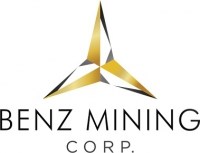
To view the source version of this press release, please visit https://www.newsfilecorp.com/release/247193

